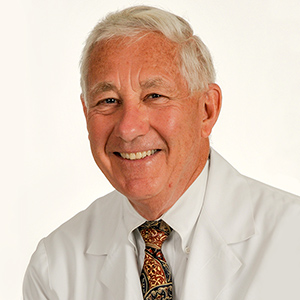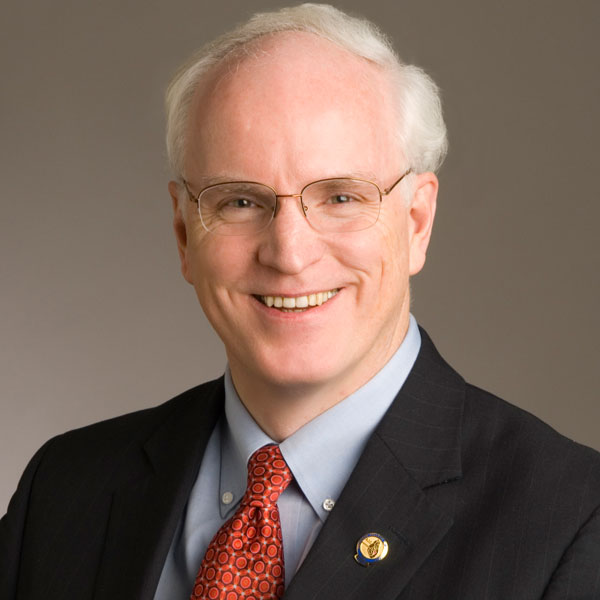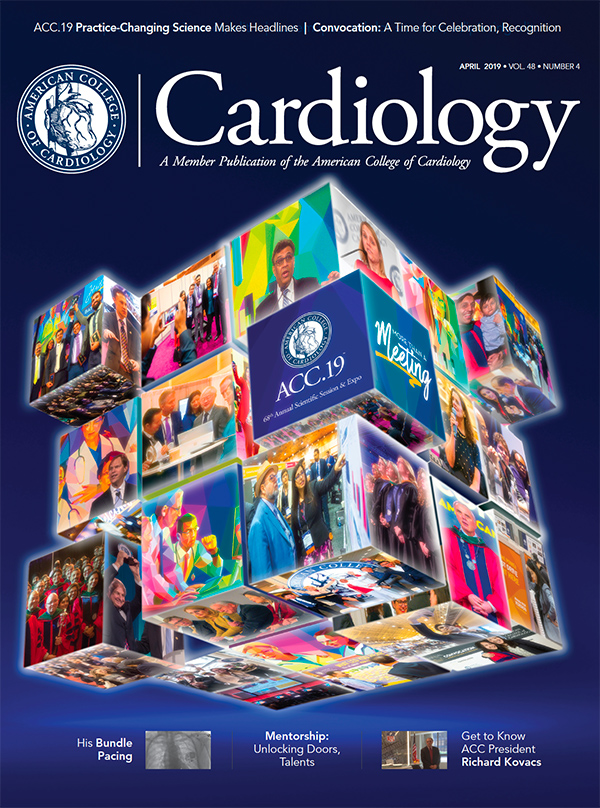Editor's Corner | ACC.19: The "Magnificent" Seven
From the Apple Heart Study to transcatheter aortic valve replacement (TAVR) in patients with critical aortic stenosis and low-surgical risk, ACC's 68th Annual Scientific Session brought advancements across many areas of cardiology. Here's our top seven picks of the trials that'll impact practice.
Apple Heart Study
The Apple Heart Study provides a tantalizing view of the future potential of wearable smartwatch sensor technologies to detect cardiac arrhythmias in the context of precision medicine. It's a peek into the future of "monitored medicine."
In this observational study in which participants self-enrolled, the smartwatch facilitated detection of atrial fibrillation (AFib) in a small percentage who received an alert of an irregular heartbeat and then had blood flow activity and heartbeat irregularity measured by photoplethysmography.
Whether we (as physicians) like it or not, the public has easy access to the Apple watch and people will monitor themselves. But how "good" is such monitoring? Less than 1 percent of people monitored had a tachycardia notification. Only a third who received a watch notification actually had AFib – and we don't know if a short period of AFib is harmful or not! Think also of the huge amount of data such monitoring devices may generate. Our offices/hospitals would be overwhelmed by trying to make sense of the data input. Use of artificial intelligence may be the answer (see page 34 for solutions being developed by ACC). All this is coming, but more must be learned and devised before such technology becomes "standard" care.
CLEAR Wisdom
Bempedoic acid – a nonstatin inhibitor of ATP citrate lyase – was shown to be safe and effective in reducing LDL-C, vs. placebo, in patients with atherosclerotic cardiovascular disease (ASCVD) and/or heterozygous familial hypercholesterolemia on maximally tolerated statin therapy. In 740 patients who completed the study, the mean percent change in LDL-C from baseline to 12 weeks, the primary endpoint, was 15.1 percent with bempedoic acid vs. 2.4 percent with placebo. After one year, no difference was noted for clinical outcomes, although the trial was not powered for this. This safety and efficacy trial opens the door for a new agent that may become a standard part of our treatment regimen – especially for patients who are statin-intolerant. Keep your eye out for future trials that will (or will not) demonstrate the clinical outcomes effectiveness of bempedoic acid.
REDUCE-IT
A dramatic 30 percent reduction in total events was reported at ACC.19 from the longer follow-up of the REDUCE-IT trial of icosapent ethyl (a fish oil concentrate available only by prescription). The first report from this trial, last November, showed about a 25 percent reduction in risk of cardiovascular events.
Also reported at ACC.19 was a substantial reduction in second, third and fourth events – 32 percent, 31 percent and 48 percent, respectively.
Icosapent ethyl seems to be a "drug that keeps on giving." In treating 1,000 patients, more than 100 recurrent events will apparently be prevented. There is an important reminder – icosapent ethyl is not an over-the-counter fish oil. Patients should be counseled that nonprescription fish oil has not shown such reductions in either the primary or other endpoints. Further, not only is it unlikely to be useful, taking large amounts of nonprescription fish oil will be extremely expensive.
DECLARE-TIMI 58
The first cardiovascular outcomes trial of a sodium glucose co-transporter 2 (SGLT-2) inhibitor to stratify patients by ejection fractions (EF) showed that dapagliflozin was effective across a wide spectrum of EF in patients with type 2 diabetes (T2D) and heart failure (HF) to reduce the composite endpoint of cardiovascular death and HF hospitalization. DECLARE-TIMI 58 included 17,160 patients with T2D and HF with either established ASCVD or multiple risk factors for ASCVD.
Dapagliflozin on top of guideline-directed therapy reduced the risk of cardiovascular death/HF hospitalization more in patients with HFrEF (hazard ratio [HR], 0.62; 95 percent confidence interval [CI] 0.45-0.86) than in those without HFrEF (HR, 0.88; 95 percent CI, 0.76-1.02; p for interaction=0.046).
Notably, dapagliflozin reduced hospitalization for HF in both patients with and without HFrEF. It reduced cardiovascular death only in patients with HFrEF. Similar results were noted for all-cause mortality.
Dapagliflozin is now a triple threat in the treatment of diabetic patients. For the broad spectrum of patients with T2D, it has been shown to reduce ischemic events, renal events and especially hospital admissions and cardiovascular death in patients with HF. In DECLARE-TIMI 58, the latter is true especially in patients with reduced EF, but also in the larger group of all patients with HF.
With the results of DECLARE TIMI-58 in hand, dapagliflozin probably should be used early in the treatment of patients with T2D – rather than its current use as an "add-on" drug. These effects are likely a drug class effect – SGLT-2 inhibitors across the board may well produce similar beneficial outcomes.
AUGUSTUS
An unsettled question is the optimal antithrombotic regimen for patients with AFib and an acute coronary syndrome (ACS) or who undergo PCI. Oral anticoagulation (OAC) is indicated to prevent stroke and systemic embolism in AFib, but has not been shown to prevent stent thrombosis. Dual antiplatelet therapy (DAPT) is proven to reduce recurrent ischemic events and stent thrombosis, but is less effective in reducing cardioembolic stroke associated with AFib.
Triple therapy with a vitamin K antagonist (VKA), aspirin and clopidogrel has been recommended as optimal antithrombotic therapy for patients with an indication for OAC undergoing PCI with stent implantation. Triple therapy increases bleeding risk. Alternative regimens including non-VKA OACs appear to offer advantages over VKA, including the potential for less bleeding.
In AUGUSTUS, after six months, the bleeding risk was significantly reduced by 31 percent in patients taking apixaban vs. warfarin and 47 percent in patients taking placebo vs. aspirin. No significant difference was seen for ischemic events in relation to whether treatment included either or both VKA and aspirin.
Several studies now suggest it's safe to treat patients with AFib who require antiplatelet therapy with anticoagulation: WOEST with warfarin; PIONEER AF-PCI with rivaroxaban; RE-DUAL PCI with dabigatran; and AUGUSTUS with apixaban.
This is a practice-changing trial! The outcome kernel is in this sentence: The combination of apixaban and a P2Y12 inhibitor (such as clopidogrel) without aspirin provided the safest treatment regimen in the study group without significantly increasing ischemic events such as heart attacks, strokes and blood clots. For patients with AFib in need of a stent, "triple therapy" is now relegated to the dustbin, and warfarin should be excluded from the interventionalists' poststent therapy.
STOPDAPT-2
Current guidelines recommend DAPT, consisting of aspirin and a P2Y12 inhibitor such as clopidogrel, for at least 12 months after implanting a drug-eluting stent (DES). The STOPDAPT-2 trial from Japan now has provided evidence that one month of DAPT, followed by clopidogrel monotherapy out to 12 months, was superior to the standard 12 months of DAPT for preventing net adverse ischemic events. The rate of primary outcome events was significantly lower in the one-month DAPT group (2.4 percent, vs. 3.7 percent for 12-month DAPT; p for superiority=0.04). Death, myocardial infarction (MI), stent thrombosis, stroke and TIMI major/minor bleeding at one year comprised the primary outcome.
One-month DAPT was noninferior to 12-month DAPT at preventing major adverse ischemic events and superior to 12-months DAPT at preventing TIMI major/minor bleeding.
In this trial of 3,045 patients, aspirin was stopped at one month in 96 percent of patients in the one-month DAPT group and DAPT was continued up to one year in 88 percent of patients in the 12-month DAPT group.
The results of STOPDAPT-2, along with the results of the GLOBAL LEADERS Adjudication Sub-Study (GLASSY), will generate more debate about the optional duration of DAPT after PCI. GLASSY showed that one month of DAPT was noninferior to 12 months of DAPT at preventing death, MI, stroke or urgent target vessel revascularization.
"To bleed, or not to bleed, and of course not to clot." Trials of poststent therapy have been a constant source of debate ever since stents were introduced. But one thing seems to emerge from current discussions – short-term therapy with DAPT (probably around one month) and then continuation with a P2Y12 inhibitor for one year seems to be a good option for patients who have a high bleeding risk on aspirin. The other side of the coin, however, remains a conundrum – how to best treat patients at high risk of stent thrombosis. Though they are admittedly far less common, there will be more studies to come.
PARTNER 3 and EVOLUT
Arguably the most anticipated interventional trials presented at ACC.19, PARTNER 3 and EVOLUT tested TAVR (one using the Edwards TAVR system, the other using the Medtronic TAVR system) against standard surgical aortic valve replacement (SAVR). Both were designed as noninferiority trials, but surprisingly TAVR "beat" SAVR in both studies. SAVR was superbly performed in both trials and set a high standard.
In PARTNER 3, there was a 46 percent reduction in the composite endpoint (death, stroke, hospitalization) with TAVR vs. SAVR. Also, death or disabling stroke occurred in only 1 percent of the TAVR group at the one-year follow-up. In EVOLUT, TAVR also "beat" SAVR when stroke was added to the combined endpoint of death and hospitalization at two years.
The summation of these two trials is a synergistic one: Now, even in low-risk patients with aortic stenosis in need of AVR, TAVR must be included in any conversation concerning the options within informed consent.
Do these studies show that all patients with aortic stenosis should have a TAVR? Absolutely not! Some young patients with a biscuspid valve (e.g., a 42-year-old with a bicuspid valve and symptoms) may be better served with a mechanical AVR. Trials are underway evaluating TAVR in patients with bicuspid valves, but remember that congenital bicuspid valves are associated with proximal aortopathy. Combined AVR and proximal aortic repair is still a surgical procedure. Nonetheless, these two trials support TAVR in most patients with aortic stenosis. And perhaps, in the not too distant future, proximal aortic repair may well be within the armamentarium of transcatheter specialists. Stay tuned…
Clinical Topics: Acute Coronary Syndromes, Anticoagulation Management, Arrhythmias and Clinical EP, Cardiac Surgery, Dyslipidemia, Heart Failure and Cardiomyopathies, Invasive Cardiovascular Angiography and Intervention, Valvular Heart Disease, Anticoagulation Management and ACS, Anticoagulation Management and Atrial Fibrillation, SCD/Ventricular Arrhythmias, Atrial Fibrillation/Supraventricular Arrhythmias, Aortic Surgery, Cardiac Surgery and Arrhythmias, Cardiac Surgery and Heart Failure, Cardiac Surgery and VHD, Lipid Metabolism, Nonstatins, Novel Agents, Primary Hyperlipidemia, Statins, Acute Heart Failure, Interventions and ACS, Interventions and Structural Heart Disease
Keywords: ACC Publications, Cardiology Magazine, ACC Annual Scientific Session, ACC19, Acute Coronary Syndrome, Aortic Valve, Aortic Valve Stenosis, Aspirin, Artificial Intelligence, Atrial Fibrillation, Confidence Intervals, Diabetes Mellitus, Type 2, Eicosapentaenoic Acid, Drug-Eluting Stents, Fibrinolytic Agents, Embolism, Fish Oils, Glucose, Follow-Up Studies, Hospitalization, Heart Failure, Hyperlipoproteinemia Type II, Mitral Valve, Malus, Myocardial Infarction, Photoplethysmography, Pyridones, Risk Factors, Sodium, Pyrazoles, Stroke, Stroke Volume, Symporters, Tachycardia, Specialization, Ticlopidine, Transcatheter Aortic Valve Replacement, Warfarin, Thrombosis, Hydroxymethylglutaryl-CoA Reductase Inhibitors
< Back to Listings



